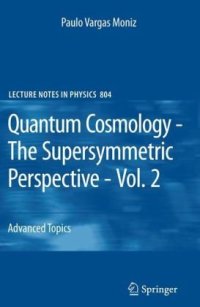
Ebook: Quantum Cosmology - The Supersymmetric Perspective - Vol. 2: Advanced Topic
Author: Paulo Vargas Moniz (auth.)
- Genre: Physics // Astronomy: Astrophysics
- Tags: Quantum Field Theories String Theory, Cosmology, Classical and Quantum Gravitation Relativity Theory, Elementary Particles Quantum Field Theory
- Series: Lecture Notes in Physics 804
- Year: 2010
- Publisher: Springer-Verlag Berlin Heidelberg
- Edition: 1
- Language: English
- pdf
The two volumes that comprise Quantum Cosmology tackle the quantum description of the early universe from the perspective of supersymmetric models of elementary particle physics.
The first volume is an accessible primer that covers the basics of the field, critically discussing ideas and concepts that comprise our current knowledge of supersymmetry and supergravity. After reviewing the fundamentals, it provides a thorough analysis of a first set of quantum cosmological models. The second volume is dedicated to more advanced topics. In it, the scope for analyzing quantum cosmological models within a supersymmetric framework is broadened.
As much as possible, these two volumes treat what we know, what we think we know and what we think we do not know on an equal footing. Complete with problems and solutions for each chapter, the books are ideal for young, inquisitive minds eager to embark on in-depth research in this field. They provide readers with the tools they need to go on their own, pushing them to ask the right questions rather than seek definitive answers.
The two volumes that comprise Quantum Cosmology tackle the quantum description of the early universe from the perspective of supersymmetric models of elementary particle physics.
The first volume is an accessible primer that covers the basics of the field, critically discussing ideas and concepts that comprise our current knowledge of supersymmetry and supergravity. After reviewing the fundamentals, it provides a thorough analysis of a first set of quantum cosmological models. The second volume is dedicated to more advanced topics. In it, the scope for analyzing quantum cosmological models within a supersymmetric framework is broadened.
As much as possible, these two volumes treat what we know, what we think we know and what we think we do not know on an equal footing. Complete with problems and solutions for each chapter, the books are ideal for young, inquisitive minds eager to embark on in-depth research in this field. They provide readers with the tools they need to go on their own, pushing them to ask the right questions rather than seek definitive answers.